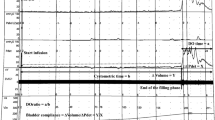Abstract
Introduction: Healthy individuals have a nocturnal decrease in urine output due to increased plasma antidiuretic hormone levels at night. This does not occur in spinal cord injury and most patients experience nocturnal polyuria, which triggers dysreflexic crises secondary to urinary bladder overdistension, and interferes with patients' sleep due to the need for extra catheterization. Objective: To evaluate the diurnal variation in ADH level, urinary output, and plasma and urine osmolality in SCI patients with regard to their level of injury and in comparison with age- and sex-matched healthy individuals. Materials and methods: Sixteen ASIA-A spinal cord-injured patients, eight with paraplegia, eight with tetraplegia, and eight healthy individuals, were evaluated for urinary output, urine and serum osmolality, and antidiuretic hormone levels during day and night hours. Results: Absence of diurnal variation in urinary output and antidiuretic hormone secretion was detected in both paraplegic and tetraplegic patients, while antidiuretic hormone levels rose significantly at night in the control group. Conclusion: Antidiuretic hormone levels should be monitored both day and night in spinal cord injury patients with severe nocturnal polyuria. Treatment with desaminocystein-D-arginine vasopressin can be attempted when conservative measures fail to control nocturnal polyuria, especially in patients who are on an intermittent catheterization program.
Similar content being viewed by others
Log in or create a free account to read this content
Gain free access to this article, as well as selected content from this journal and more on nature.com
or
Author information
Authors and Affiliations
Rights and permissions
About this article
Cite this article
Kilinç, S., Akman, M., Levendoglu, F. et al. Diurnal variation of antidiuretic hormone and urinary output in spinal cord injury. Spinal Cord 37, 332–335 (1999). https://doi.org/10.1038/sj.sc.3100814
Published:
Issue date:
DOI: https://doi.org/10.1038/sj.sc.3100814
Keywords
This article is cited by
-
Early urinary tract infection after spinal cord injury: a retrospective inpatient cohort study
Spinal Cord (2020)
-
Comparison of diurnal blood pressure and urine production between people with and without chronic spinal cord injury
Spinal Cord (2018)
-
Diurnal blood pressure and urine production in acute spinal cord injury compared with controls
Spinal Cord (2017)
-
Acute Changes in Systemic Hemodynamics and Serum Vasopressin After Complete Cervical Spinal Cord Injury in Piglets
Neurocritical Care (2010)
-
Intermittent catheterization: which is the optimal technique?
Spinal Cord (2002)



